How Much Does a Privacy Fence Cost?
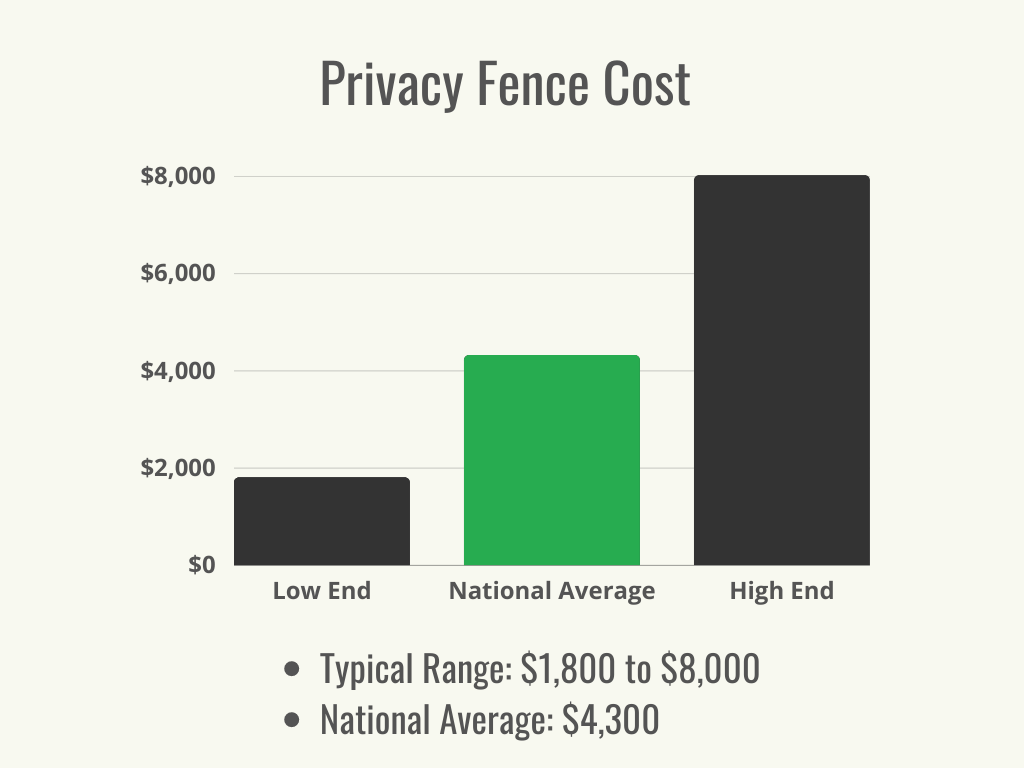
Highlights
The typical range for privacy fence installation cost is $1,800 to $8,000, with a national average of $4,300.
Yard size, fence size, fence material and style, additional materials, gates, fence height, terrain, and labor all contribute to the cost of a privacy fence.
A privacy fence can act as a visual property marker, increase safety and security, enhance the aesthetics of a property, add privacy, and increase property value.
Homeowners who have the experience and the tools to install a privacy fence may be able to handle this project themselves. Otherwise, hiring a professional can ensure that the job is done efficiently and effectively.
Keeping the backyard protected from the prying eyes of neighbors—even friendly ones—can help make it a relaxing oasis. Some landscapes are suited for tall rows of trees or hedges, but for many, an attractive privacy fence can offer a secluded space and a lovely background for plantings or playscapes. Fencing can be a significant investment, so it’s important for homeowners to budget carefully and consider the additional costs, such as for permits, excavation, installation, and finish. It’s a worthwhile investment: Sturdy, nice-looking fencing can increase curb appeal, as home buyers with children or pets often consider fencing to be a must-have, and it can increase the homeowner’s own enjoyment of their backyard. So how much does a privacy fence cost? According to Angi, the cost ranges from $1,800 to $8,000, with a national average of $4,300. The exact privacy fence cost is dependent on a lot of choices a homeowner makes about the purpose, style, and size of the fence, so there are many opportunities to customize the project. These variables are explained in detail below.
Escape Prying Eyes
Maybe it's time to call in a fencing pro. Get free, no-commitment project estimates from professionals near you.

+

How to Calculate Privacy Fence Cost
There are many styles of fencing available to choose from, so once the homeowner has measured their yard, they can adjust their budget and the estimated total cost based on the materials they select and the height of the fence. Instead of using a privacy fence cost calculator, homeowners can follow the following steps to come up with a cost estimate.
Measure the area to be enclosed. Take into consideration the location of the property lines and the placement inside them required by local codes for fence installations. This is the linear footage of fencing that is needed.
Select a height and style of fencing that complement the yard. Be sure to take into account landscaping, terrain, and style preferences.
Choose the material. It’s a good idea to strike a balance between aesthetics, durability, and cost-effectiveness.
Check the post spacing required by local codes or the spacing recommended by the fence manufacturer. Divide the linear footage number by the post spacing number, and add two. That’s how many posts will be needed.
Multiply this number. Multiply this number by two or three (depending on the height of the fence) to calculate how many rails are needed.
Measure for wood fences. If opting for a wood fence, divide the total linear footage number by the width of the pickets to calculate how many rails, pickets, and posts are needed.
Measure for panel fencing. If opting for fencing sold in panels, divide the linear footage by the width of the panels.
Add the cost of gates and hardware. It’s likely at least one gate will be needed for homeowners to exit the yard. If so, the cost of the gate and hardware will add to the total cost.
Consider finishing touches. For wood fences, add the cost of stain, finish, or both.
Add the cost of permits. If the area requires permits to install fences, add that cost.
Factor in labor costs. Privacy fence installation is a big job, especially if the yard isn’t level. Consider the cost of hiring a professional.
Factors in Calculating Privacy Fence Cost
The average cost of a privacy fence is $4,300, but this cost can be significantly higher or lower due to the variety of shapes, styles, and materials of fencing available. This is beneficial to homeowners in several ways: If a backyard fence is important and cost is the chief consideration, it’s possible to choose materials that are less costly in order to get the job done swiftly. However, there are quite a few factors for a homeowner to consider when forming a budget and plan.
Yard Size
Fencing materials are priced based on the cost per linear foot. Therefore, the size of the area to be enclosed will determine everything else about the cost. The measurement of the number of feet of fencing material needed guides the total cost, with larger or oddly shaped yards costing more than smaller yards and those that don’t require rails or panels to be cut. Homeowners can expect to pay between $10 and $50 per linear foot for privacy fencing.
Fence Material
Privacy fencing is available in bamboo, wood, vinyl, aluminum, and composite. Both the material and installation costs vary, with a wood privacy fence costing $2,700 on average and aluminum being the most expensive at around $4,600. A vinyl fence costs $3,700 and is a popular choice for its durability. Many homeowners find themselves considering wood vs. vinyl fencing since both are very popular options. Fence materials will be covered in more detail in a section below.
Fence Style
The style of fence a homeowner selects will also affect the pricing: Picket fences, iron, and split-rail styles provide a little less privacy but cost less and can be a great option for gardeners looking to trail plantings up the fence. Stockade and vinyl panel fences are a bit more expensive but offer more complete privacy and are quite sturdy. Wood pickets take more time to install properly and will increase labor costs. Lattice work and stylized post caps add more to the total. This choice will be balanced between the look, cost, and level of privacy the homeowner is hoping for.
Materials Needed
In addition to panels or wood posts, there are a variety of additional materials required to make a privacy fence complete. At least one gate is typically needed for homeowners to enter and exit the yard, and these tend to cost $275 apiece (gates that open automatically will be pricier). Some types of fence posts are secured with concrete bases, which cost $0.30 per pound. Posts range from $4 to $90 apiece depending on the materials, and post caps average $30 each. Panels are about $270 each, and top and bottom rails cost $80 each.
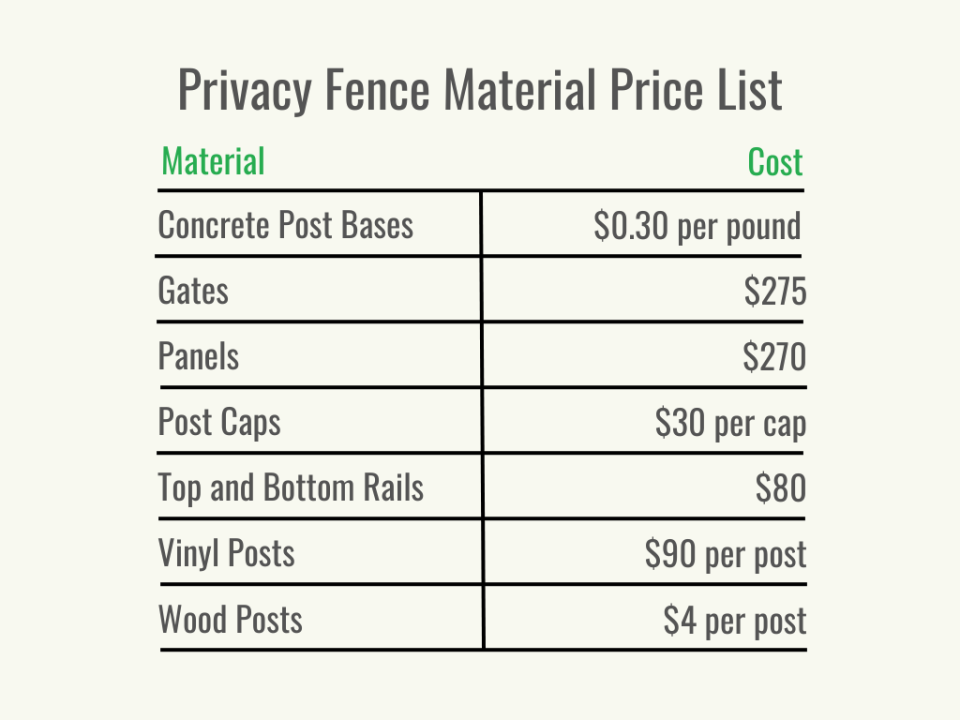
Photo: bobvila.com
Gates
Gates are priced by the piece (usually around $275 on average) and also require hinges and fastening hardware. While a gate may initially seem unnecessary, gates are useful in the long run, providing a shortcut through the property. Gates also offer curb appeal, so another choice for a homeowner to make is whether the gate will be included on one side or both sides of the house. When homeowners are balancing convenience against the cost, the number of gates can add to or subtract from the overall cost.
Fence Height
Privacy fences come in standard 6-foot and 8-foot sizes. Installing 150 linear feet of fencing will cost about $4,700 for a 6-foot fence and $6,300 for an 8-foot fence. Local regulations may limit the height that can be installed, and there can be a difference in these codes based on the height of the material itself versus the height off the ground. Therefore, it’s important for a homeowner to check on the specifics: An 8-foot fence installed on a hill over a significant dip in the ground can turn into a 10-foot total height that violates regulations. Additionally, 8-foot fencing can add as much as 35 percent to the total cost of the project, so homeowners will want to carefully consider how much the fencing needs to block out.
Terrain
The posts that support any privacy fence need to be dug deeply into the soil and sometimes cemented to prevent the fence from collapsing or blowing over in windy or snowy conditions. Soil that’s rough and rocky, heavy clay, soil with many roots running through, and hilly terrain can all make the digging of post holes difficult and time-consuming, so labor costs will increase. If the yard needs to be leveled before the fence is put in, this will add about $900 to $3,000 to the overall cost. In some cases, a root or rock cannot be removed and the placement of the post must be adjusted accordingly, which can add material and labor costs. Tree removal costs $200 to $2,000 per tree, and grinding tree stumps runs $320 on average.
Labor
The cost to have professional installation of fencing will vary based on the material, but it averages around $35 per hour. The labor cost to install a privacy fence can total $840, since the entire process takes around 24 hours on average. That includes professional measurement, purchase of materials, delivery, installation, and cleanup and usually also includes a warranty.
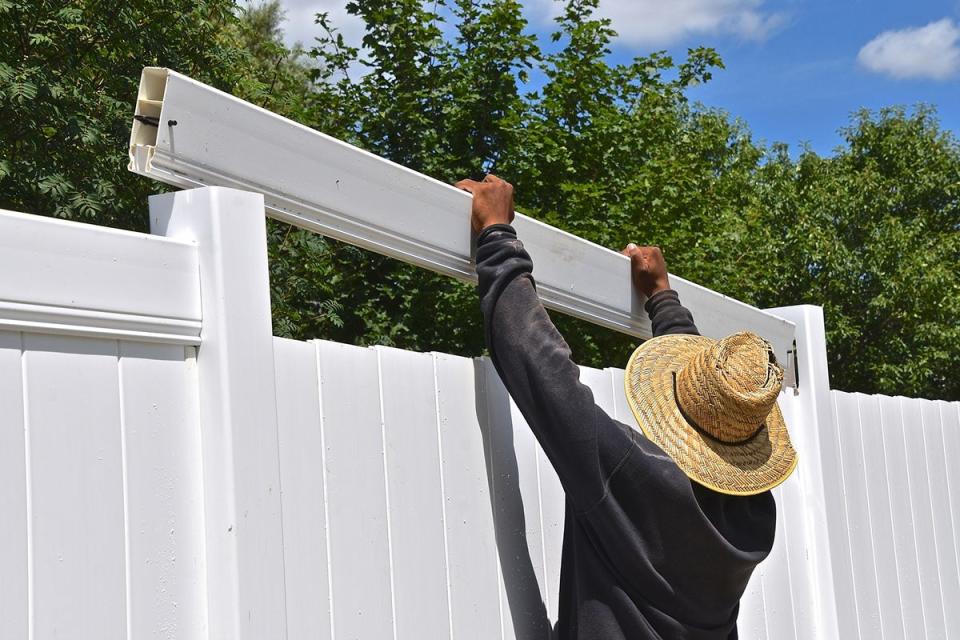
Photo: depositphotos.com
Additional Costs and Considerations
There are additional costs and considerations for homeowners to take into account before settling on a budget for the total cost of their privacy fence—or even deciding to install a privacy fence around their property. Some of these costs are unavoidable, depending on where the home is located.
Permits
Because fence installation usually requires digging, homeowners or their contractors will need to call 811 (the national “call before you dig” phone number) to check for hidden utility lines before beginning. That’s a free service, but the cost of moving any utilities that are in the way won’t be. Local government or homeowners associations (HOAs) may also require permits or fees and a follow-up inspection. Most permits cost somewhere in the range of $20 to $60. Because privacy fences also affect neighbors, homeowners are highly advised to get a permit; removing and reinstalling a fence that doesn’t meet requirements can be hugely expensive and can also be frustrating to neighbors. Some localities require that the “pretty” side of the fence face outward as well, so homeowners will want to make sure they apply for permits and check the regulations before finalizing their fence choice and beginning work.
Existing Fence Removal
Removing an existing fence can be a surprisingly large expense: Even if a homeowner decides to DIY, fence posts that are set in concrete can be difficult to get out, and there may be a separate cost for disposal of the old fence materials, especially if they’re pressure-treated wood. Homeowners can expect to pay between $3 and $5 per linear foot for a professional to remove existing fencing.
Landscaping
Ideally the area where the fence is to be placed will be clear of undergrowth and planting, but often yard perimeters have shrubs, groundcover, or trees in place. Some may need to be removed, which costs about $400 to $900 when a professional landscaper completes the job. Others (for example, larger shade trees or old trees that add character to the yard) may require the fence installers to implement creative work-arounds. Planting new plants after the fence is installed usually costs $25 to $50 each.
Painting and Sealing
Wood fences require finishing to stand up to the elements. A well-applied coat of clear sealant will allow the wood to weather slowly and gracefully, whereas a coat of exterior paint can add color to a plain yard. The fence installers can complete this step, or homeowners can learn how to stain a fence themselves. Either way, homeowners will want to plan on purchasing enough paint, stain, or sealant to cover the fence after installation and then add materials and time to the budget in future years for maintenance and upkeep of the finish. Depending on the type of sealant and the size of the fence, this can cost $750 to $4,250. Alternatively, vinyl fences never require paint or sealant of any kind, which may make them a more affordable option in the long term.
Customization
It’s often the final flourishes that make a privacy fence truly beautiful. Elegant metalwork, intricate lattice, custom finials, or even unusual wood selections can make a fence stand out from the neighbors’ and add curb appeal—but these touches will add to the overall cost. Some homeowners pay as much as $85 per linear foot for custom privacy fencing.
Want to Turn Your Backyard Into An Oasis?
Maybe it's time to call in a fencing pro. Get free, no-commitment project estimates from professionals near you.

+

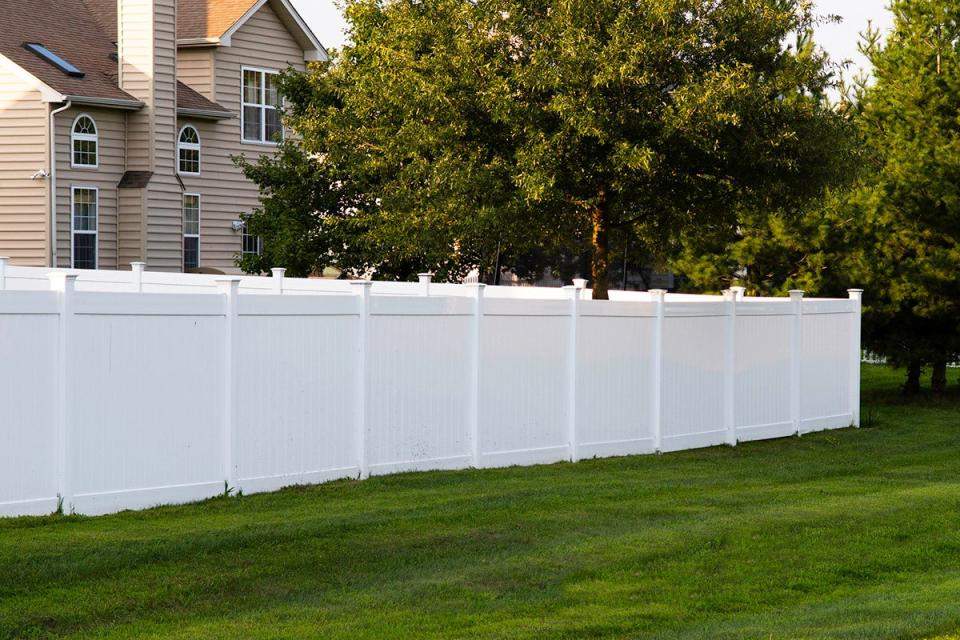
Photo: depositphotos.com
Privacy Fence Cost by Type of Material
Homeowners have a lot of options when it comes to types of fence materials for their privacy fences. Each has benefits and drawbacks, and there can be significant cost differences both because of the expense of the materials themselves and the cost of labor to install them. All of the options will provide privacy, with varying levels of protective enclosure for pets and children.
Fence Material | Average Cost (Materials Only) |
Aluminum | $4,600 |
Bamboo | $2,800 |
Composite | $4,200 |
Vinyl | $3,700 |
Wood | $2,700 |
Aluminum
Aluminum fencing looks clean and modern and lasts for a long time with little maintenance. The rails are generally a bit farther apart than wood pickets, so as a privacy fence, aluminum fencing will require a bit of landscaping to block the neighbors’ view. The biggest drawback is the cost of installation: The process is difficult and can add a higher labor cost than other types of fence materials. An aluminum fence costs an average of $4,600.
Bamboo
For the environmentally conscious homeowner, sustainable bamboo fencing can be a great privacy option. This fencing can be planted live, where it will grow into a dense, prunable fence, or it can be purchased cut, dried, and bound, which renders the wood almost maintenance-free. Usually sold in rolls that are mounted to metal or wood posts, the sticks of bamboo are bound together closely to provide an enclosure with a natural look. Bamboo fencing costs between $13 and $24 per linear foot for materials (or $2,800 on average), is long-lasting, and does not require sealing and painting.
Composite
Fences made of composite wood are both durable and attractive, making them a popular alternative to solid wood. However, composite fences are significantly more expensive than wood, costing $4,200 on average. One thing for homeowners to consider is that composite requires less maintenance, such as staining or painting, and it can withstand weather and pests more effectively than wood. This may mean paying less for upkeep and maintenance in the long run despite the relatively high up-front cost.
Vinyl
Maintenance-free, easy to clean, easy to install, and mid-priced, vinyl fencing is available in multiple colors and styles. The total cost to install a vinyl privacy fence is around $3,700. Vinyl is not always an appropriate choice, though. Because the panels do not allow airflow, they can blow over or crack in high wind conditions, and in extreme heat they can soften or buckle. While vinyl fencing costs more per foot up front than some other options, it does not require time-intensive, costly maintenance, so the lifetime cost may be similar. For many applications, however, vinyl is a long-lasting, low-maintenance option.
Wood
Wood fences are classic and blend well into almost any neighborhood. Whether a homeowner is looking for pickets, stockade, rail, or other styles, wood fences can be built out of many different types of timber and painted or stained. In this case, “traditional” doesn’t have to mean “boring.” Wood fence panels can be installed horizontally for a more modern look, or they can be built on a diagonal for a transitional style. Latticework, finials, or post caps can be added to customize the look. Wood fences cost $2,700 on average, but costs can range widely depending on the wood type, height, and style.
Do I Need a Privacy Fence?
While some homeowners prefer the spacious feel of a wide-open yard, there are many reasons installing a backyard fence might be a good choice. Fences keep animals and people in or out, protect a property, and provide security, all of which can make the yard feel more like a haven and less like a public space.
Marking a Property
Placing a fence on the perimeter of a yard clearly demarcates where a property begins and ends, especially in areas where installing a fence requires confirmation of the property lines. This can be helpful when planning renovations or changes to the property, as it will help homeowners know precisely how much room they have to work with. In addition, a fence can clarify where a homeowner’s mowing and maintenance responsibilities begin and end and can prevent disputes with neighbors over those tasks. Finally, in areas with a lot of wide-open space or farmland, a fence can protect land from encroachment when boundaries are clearly staked.
Safety and Security
Families with younger children who want to play outside know that taking one’s eyes off a child for even a moment in an unsecured space can mean they run into the road or encounter an unsecured animal or pet. Plenty of parents and pet owners have practiced the mad dash down the street to retrieve a little wanderer. And even those without pets or children may have been surprised by a dog or person unexpectedly appearing in the yard. A fence can make it easier to keep tabs on kids and pets and protect homeowners from unwanted surprises. Fences also create a barrier to break-ins or vandalism: Providing an additional obstacle for criminals or mischief-makers to overcome means they’re more likely to move on. If there is a pool on the property—even a temporary one—local regulations or homeowners insurance may require fencing to protect against drowning accidents.
Decoration
A well-chosen fence can add beauty and shape to a yard. Decorative scrollwork and lattice create dimension, while a plain, simple wood fence can be the backdrop that makes the colors and textures of a lush garden pop rather than blending into the neighbor’s greenery. Fencing can also be used to separate a yard into distinct areas for dining, lounging, or swimming, genuinely creating an outdoor living space.
Added Privacy
Reading quietly by a pool, disastrously losing at badminton, relaxing in a hot tub after work, or enjoying dinner and a movie with family—these activities can be blocked from prying eyes with a privacy fence. Even those with good relationships with their neighbors don’t necessarily want to invite them into every moment of their life, especially during precious leisure time. Fencing can add privacy to the entire yard or to smaller areas where privacy is particularly important. In addition, if neighboring houses are very close by, privacy fencing can interrupt the sight lines from the neighbor’s kitchen, meaning it won’t be necessary for homeowners to keep the curtains constantly drawn for privacy.
Increased Property Value
Does a fence increase property value? It can certainly increase curb appeal, but the answer to this question is a mixed bag, because it varies by region, neighborhood, and potential buyer pool. A well-kept fence is almost never going to reduce the value of a home, so there is no need for homeowners to worry that it will decrease the property value. In suburban areas where buyers are likely to have dogs or young children, real estate agents suggest that a well-maintained fence be added to a property. The value of properties in urban areas with smaller yards would also likely go up with the addition of a privacy fence, as built-in privacy without the need to install a fence is a great benefit to potential buyers. The key to a fence’s value in terms of home price is its condition. A beautiful, sturdy, well-kept fence adds charm and curb appeal and can really make the appearance of a home stand out. However, real estate agents often caution that adding a fence just for the purpose of a sale will likely not recoup the cost of installation.
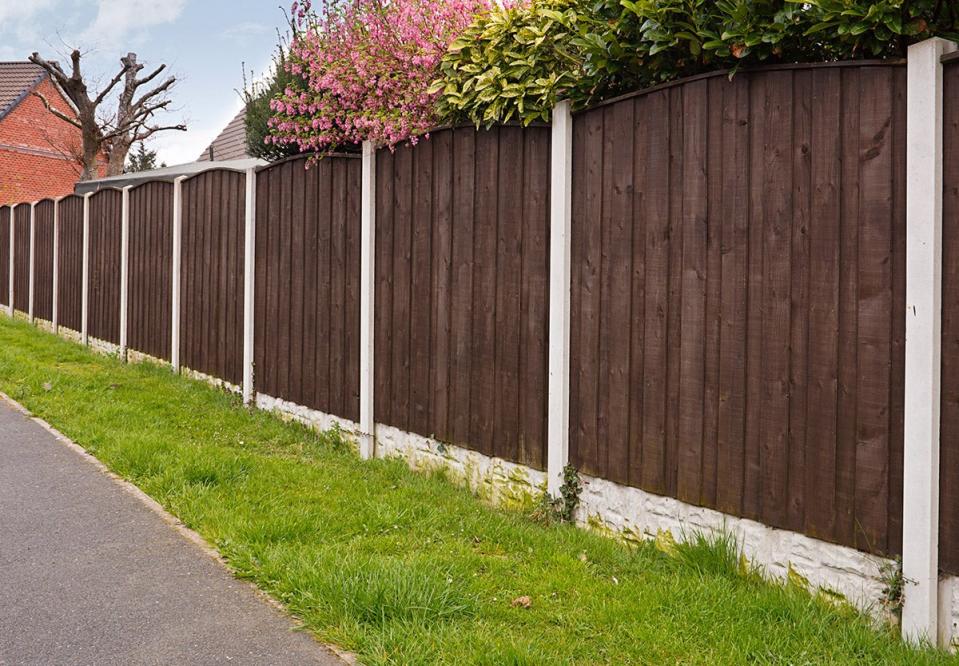
Photo: depositphotos.com
Privacy Fence Installation: DIY vs. Hiring a Professional
Some fence styles can certainly be installed by homeowners who have the correct tools and know-how. This can save money on labor costs and allow the homeowner to curate their own timeline and customize the fence and installation as they please. Putting up a fence can create a great sense of accomplishment. Chain link, wood, some vinyl, and potentially some steel fences can be achieved by committed homeowners, while aluminum and wrought-iron fences will likely be a difficult DIY. For a quick fix, there are also some simple ways to add privacy to a chain link fence that many homeowners are capable of doing if they’re looking for cheap fence ideas that provide some backyard privacy.
Hiring one of the best fence companies can save homeowners time, expense, and frustration and result in a precise and polished finish. Even for experienced homeowners, fence-building will require a fair amount of research and significant labor time—usually far more time than an experienced crew will need. Rental or delivery costs for materials and specialty tools can add up quickly, and the cost of the materials themselves can be higher for individual buyers than for contractors by a significant margin. Therefore, making this a DIY project may not result in as big a savings as anticipated. A contractor will likely have installed fences in dozens of different configurations and conditions and will have the know-how to deal with challenges such as uneven ground, unmovable roots, overhanging trees, and navigation of the sometimes complicated permitting and inspection rules. A fence is a long-term installation, so it’s best to make it sturdy, stable, and beautiful on the first try.
Make Your Private Space Actually Private
Maybe it's time to call in a fencing pro. Get free, no-commitment project estimates from professionals near you.

+

How to Save Money on Privacy Fence Cost
Careful planning and creative thinking are the best ways to save money on fence installation costs. By doing some homework prior to purchasing materials, homeowners can prevent costly errors and make sure they have budgeted correctly.
Choose less expensive materials. Check out different materials in person at a local home improvement or hardware store to determine the cheapest one that will work for your needs. Just be sure to compute the total cost of materials, installation, and maintenance.
Comparison shop for materials. If you’re buying your own, big-box stores are convenient, but lumber yards and fencing suppliers may have better rates and employees who can help make sure you have the right materials for the job.
Alternate heights. Remember that a fence doesn’t necessarily need to be the same height all the way around. A shorter fence at the front of the yard or along a neighbor’s yard, with a taller section at the back or one side, can help you save significantly on material costs.
Acquire all permits. Permitting errors can result in expensive takedowns and reinstallation if you build too close to a neighbor’s property line, and failing to inquire about permits can be disastrous if you hit a gas or electrical line.
Wait for the offseason. The warmer months are peak season for fence installation. If you’re hiring a professional to install a fence, consider scheduling your job during the slower season, when schedules are likely to be less busy and rates may be lower.
Questions to Ask About Privacy Fence Installation
Because fence installation involves digging into the yard, there is always the possibility of unknown obstacles. Homeowners will want to make sure they ask a contractor the correct questions, as this can save time, money, and frustration. The questions below can help homeowners get started.
Are you licensed and insured?
What kind of timeline do you envision for this job?
Who handles the permits and checks with utility companies?
Is there a warranty on the materials, the installation, or both? If so, for how long?
What constitutes a warranty claim, and how do I place one?
Are my property markers present, or do I need to have a survey done?
Is my yard accessible for your equipment, or do I need permission from neighbors to move equipment through their property?
What kind of fencing do you install?
What kind of fence will best meet my needs?
What challenges do you foresee in this job?
How will unanticipated problems be handled?
FAQs
Building a fence presents a great opportunity to add private space to a property, and a well-chosen fence can add appeal and security to a yard. The number of options and considerations can be mind-boggling, however, so below are a few frequently asked questions and their answers to help homeowners with their decision.
Q. How do I estimate the cost of a fence?
The biggest variables will be the number of linear feet of fencing, the height of the fence, and the material. Measure the yard’s perimeter, decide on a style, and then multiply the cost of the fence materials by the number of feet. Then consider gates, maintenance, and the cost of installation. Some internet calculators can provide a rough feel for the amount based on average material costs, but it’s just as easy to check with suppliers.
Q. What type of fence do I need?
The answer to this question depends on what you’re looking for. For true privacy, a wood stockade or vinyl panel fence will provide the most seclusion and prevent passersby from seeing into the yard at all. Wood or vinyl pickets, aluminum, chain link, and steel fences will provide excellent enclosure of the yard while maintaining an open feel, and combining them with landscaping can create a fine visual barrier. Bamboo, wire, and ranch fencing provide customizable applications, while wrought iron adds beauty and design options. After homeowners establish the purpose of the fence and the look it will have, budget considerations will help make this decision.
Q. How long does a fence last?
While the longevity of any fence is somewhat dependent on the climate and conditions, a well-installed, well-maintained fence should last between 15 and 20 years. A galvanized chain link fence costs $2,090 on average and can last much longer, while inexpensive softwood fences may only last between 7 and 10 years. Proper maintenance makes a huge difference here; even a strong fence will collapse or fail if it doesn’t get an occasional coat of sealant or paint.
Q. How do I maintain my fence?
Different materials require different maintenance levels and schedules. Vinyl fences require nothing more than a wash with soapy water and a soft brush every few months. It’s also important that vinyl fences not be subjected to the heat from gas grills and smokers and that they never be painted. Metal fences need to be protected from rust damage with regular cleanings using soapy water and a brush and occasional reapplication of epoxy or sealant as directed by the manufacturer. Wood fencing requires a bit more: Bleach application and pressure washing will remove any mold that begins to grow, and restaining or resealing must be done every few years. Regardless of the type of fence, prompt repairs of any damage are essential: A loose board or tie will quickly lead to other loose boards or sagging sections if not repaired immediately, causing the fence to fail prematurely. It’s also worth noting that while some homeowners insurance covers fences, a claim may be denied if the fence has been poorly maintained.